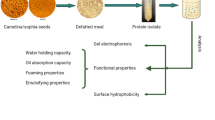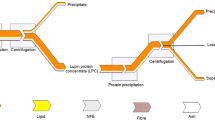Abstract
Watermelon (Citrullus lanatus) seed meal contains significant amount of extractable protein which can be used as nutritional and functional ingredients in food formulations. Alkali (0.1 M) and NaCl (0.5 M) were used to prepare protein isolates and concentrates from the defatted watermelon seed meals. Protein isolates reported protein yield of 35.15–38.27% and protein content (79.05–83.79%) which was significantly (p≤0.05) higher than the protein concentrates. SDS-PAGE of protein isolates and concentrates showed major polypeptides in the range of 74.72–110.42 kDa. Also, in vitro pepsin digestibility showed that most of the proteins were readily digested within 30 min of hydrolysis. Amino acids were dominated by arginine, aspartic, and glutamic acid. DSC results indicated that protein concentrates had significantly (p≤0.05) higher denaturation temperatures than protein isolates. The functional properties of concentrates in terms of solubility and surface properties were better than respective isolates. The results indicated that NaCl extracted proteins had comparatively better functional properties but their yield is significantly lower than respective protein isolates.
Similar content being viewed by others
References
Teotia MS, Ramakrishna P. Chemistry and technology of melon seeds. J. Food Sci. Technol. 21: 332–340 (1984)
Khalil MM. Factors affecting production of melon seed kernel protein: Yield, composition, and protein isolates quality. Nahrung 42: 295–297 (1998)
El-Adawy TA, Taha KM. Characteristics and composition of different seed oils and flours. Food Chem. 74: 47–54 (2001)
Quanhong L, Ze T, Tongyi C. Study on the hypoglycaemic action of pumpkin extract in diabetic rats. Acta Nutr. Sin. 25: 34–36 (2003)
Wang HX, Ng TB. Isolation of cucurmoschin, a novel antifungal peptide abundant in arginine, glutamate, and glycine residues from black pumpkin seeds. Peptides 24: 969–972 (2003)
Caili FU, Huan SH, Quanhong LI. A review on pharmacological activities and utilization technologies of pumpkin. Plant Food. Hum. Nutr. 61: 70–77 (2006)
Nkosi CZ, Opoku AR, Terblanche SE. Antioxidative effects of pumpkin seed (Cucurbita pepo) protein isolate in CCl4-induced liver injury in low-protein fed rats. Phytother. Res. 20: 935–940 (2006)
Arogundade LA, Akinfenwa MO, Salawu AA. Effect of NaCl and its partial or complete replacement with KCl on some functional properties of defatted Colocynthis citrullus L. seed flour. Food Chem. 84: 187–193 (2004)
Wani AA, Sogi DS, Shivhare US, Ahmed I, Kaur D. Moisture adsorption isotherms of watermelon seed and kernels. Dry. Technol. 24: 99–104 (2006)
Mello MLS, Bora PS, Narain N. Fatty and amino acids composition of melon (Cucumis melo var. saccharinus) seeds. J. Food Compos. Anal. 14: 69–74 (2001)
Wani AA, Kaur D, Ahmed I, Sogi DS. Optimization of watermelon seed protein using response surface methodology. LWT-Food Sci. Technol. 41: 1514–1520 (2008)
Wani AA, Sogi DS, Grover L, Saxena DC. Effect of temperature alkali concentration, mixing time, and meal/solvent ratio on the extraction of watermelon seed proteins-A response surface approach. Biosyst. Eng. 94: 67–73 (2006)
Kaur D, Sogi DS, Garg SK, Bawa AS. Flotation-cum-sedimentation system for skin and seed separation from tomato pomace. J. Food Eng. 7: 341–344 (2005)
El-Adawy TA, Rahma EH, El-Bedawey AA, Gafar AF. Nutritional potential and functional properties of sweet and bitter lupin seed protein isolates. Food Chem. 74: 455–462 (2001)
AOAC. Official Methods of Analysis of AOAC Intl. 15th ed. Method 984.13. Association of Official Analytical Chemists, Washington, DC, USA (1990)
Naczk M, Diosady LL, Rubin LJ. Functional properties of canola meals produced by two-phase solvent extraction system. J. Food Sci. 50: 1685–1688, 1692 (1985)
Paulson AT, Tung MA. Solubility, hydrophobicity, and net charge of succinylated canola protein isolate. J. Food Sci. 52: 1557–1561 (1987)
Sze-Tao KWC, Sathe SK. Walnuts (Juglans regia L): Proximate composition, protein solubility, protein amino acid composition, and protein in vitro digestibility. J. Sci. Food Agr. 80: 1393–1401 (2000)
Laemmli UK. Cleavage of structural proteins during the assembly of the head of bacteriophage T4. Nature 227: 680–685 (1970)
Bollag DM, Rozycki MD, Edelstein SJ. Gel electrophoresis under denaturing conditions. pp. 107–155. In: Protein Methods. 2nd ed. John Wiley & Sons Inc., Singapore, Singapore (1996)
Spies JR, Chambers DC. Chemical determination of tryptophan. Anal. Chem. 10: 30–39 (1948)
Meng GT, Ma CY. Thermal properties of Phaseolus angularis (red bean) globulin. Food Chem. 73: 453–460 (2001)
Thomas K, Aalbers M, Bannon GA, Bartels M, Dearman RJ, Esdaile DJ, Fu TJ, Glatt CM, Hadfield N, Hatzos C, Hefle SL, Heylings JR, Goodman RE, Henry B, Herouet C, Holsapple M, Ladics GS, Landry TD, MacIntosh SC, Rice EA, Privalle LS, Steiner HY, Teshima R, Ree R, Woolhiser M, Zawodny J. A multilaboratory evaluation of a common in vitro pepsin digestion assay protocol used in assessing the safety of novel proteins. Regul. Toxicol. Pharm. 39: 87–98 (2004)
Pearce KN, Kinsella JE. Emulsifying properties of proteins: Evaluation of a turbidimetric technique. J. Agr. Food Chem. 26: 716–723 (1978)
Giami SY, Isichei I. Preparation and properties of flours and protein concentrates from raw, fermented, and germinated fluted pumpkin (Telfairia occidentalis hook) seeds. Plant Food. Hum. Nutr. 54: 67–77 (1999)
Bell EA. Non-protein amino acids of plants: Significance in medicine, nutrition, and agriculture. J. Agr. Food Chem. 51: 2854–2865 (2003)
Giami SY. Effect of fermentation on the seed proteins, nitrogenous constituents, antinutrients, and nutritional quality of fluted pumpkin (Telfairia occidentalis Hook). Food Chem. 88: 397–404 (2004)
Wani AA, Sogi DS, Singh P, Wani IA, Shivhare US. Characterisation and functional properties of watermelon (Citrullus lanatus) seed proteins. J. Sci. Food Agr. 91: 113–121 (2011)
Damodaran S. Amino acids, peptides, and proteins. pp. 321–355. In: Food Chemistry. Fennema OR (ed). 3rd ed. Marcel Dekker, New York, NY, USA (1996)
King RD, Onuora JO. Aspects of melon seed protein characteristics. Food Chem. 14: 65–77 (1984)
FAO. Amino acid contents of foods and biological data on proteins. Food Policy and Food Science Service, Rome, Italy. pp. 131–132 (1970)
Longe OG, Farinu GO, Fetuga BL. Nutritional value of the fluted pumpkin (Telfaria occidentalis). J. Agr. Food Chem. 31: 989–992 (1983)
Uruakpa FO, Aluko RE. Heat-induced gelation of whole egusi (Colocynthis citrullus L.) seeds. Food Chem. 87: 349–354 (2004)
Liadakis GN, Tzia C, Oreopoulou V, Thomopoulos CD. Isolation of tomato seed meal protein with salt solutions. J. Food Sci. 63: 450–453 (1998)
Voutsinas S, Nakai S, Harwalker VR. Relationships between protein hydrophobicity and thermal functional properties of food proteins. Can. I. Food Sc. Tech. J. 16: 185–190 (1983)
Author information
Authors and Affiliations
Corresponding author
Rights and permissions
About this article
Cite this article
Wani, A.A., Sogi, D.S., Singh, P. et al. Characterization and functional properties of watermelon (Citrullus lanatus) seed protein isolates and salt assisted protein concentrates. Food Sci Biotechnol 20, 877 (2011). https://doi.org/10.1007/s10068-011-0122-6
Received:
Revised:
Accepted:
Published:
DOI: https://doi.org/10.1007/s10068-011-0122-6




